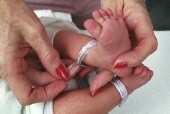
WEDNESDAY, April 17 (HealthDay News) — After five years of leveling off, the U.S. infant mortality rate is finally on the decline again, a new government report shows.
Infant mortality rates dropped 12 percent from 2005 to 2011, largely because of headway that has been made against four of the five leading causes of infant death, including birth defects, preterm birth and Sudden Infant Death Syndrome (SIDS). The rate went from 6.87 deaths per 1,000 live births in 2005 to 6.05 deaths per live births in 2011.
Although the new data did not look at why these reductions are occurring, many factors are likely at play, said study author Dr. Marian MacDorman, a statistician at the National Center for Health Statistics (NCHS). For example, there has been a crackdown on elective deliveries prior to a certain gestational age, which has reduced the number of babies born too early. If a child is born before 37 weeks of pregnancy, the birth is considered “preterm.” Such infants typically experience more health problems than babies who are born at term.
The rates of babies dying from SIDS dropped 20 percent from 2005 to 2011, and the rates of infant death due to congenital defects fell by 6 percent during the same timeframe, the report showed. Rates of infant mortality related to preterm birth and maternal complications fell 9 percent and 7 percent, respectively.
Despite the good news in the report, which was published in the April issue of the NCHS Data Brief, more work is needed, MacDorman said.
“Even though we do have a decline, preterm birth rates are much higher than in other countries, and the same is true with infant mortality,” MacDorman said. In addition, there is still a gap in mortality rates between infants born to black and white mothers.
“Infant mortality among blacks is about twice what it is for white women,” MacDorman said. However, “the decline in infant mortality among blacks is more rapid than seen with whites, so it may be that the gap is narrowing.”
Dr. Jeffrey Biehler, a pediatrician at Miami Children’s Hospital, said there will likely be even greater improvements in infant death rates in the United States in the coming years. The rate of SIDS has declined largely due to public-awareness campaigns on the importance of putting babies on their backs to sleep, he said.
What’s more, the care that babies get after birth has improved dramatically, Biehler said.
Many conditions are now diagnosed before babies are born, so all of the necessary precautions are in place by the time of delivery, he said. Prenatal care also is getting better.
“We need to continue to advocate for prenatal care for every woman, and make sure they are educated so they know to seek care as early as possible and avoid smoking and alcohol and other things that put them and their babies at risk,” Biehler said.
Dr. Lamia Soghier, a neonatologist at Children’s National Medical Center in Washington, D.C., said the push for better prenatal care is definitely paying off.
“It starts with the mom, and goes all the way through,” she said. “Obstetricians are doing a fabulous job of reducing elective deliveries before 37 weeks too.”
Better prenatal care also is contributing to earlier identification of babies with potential health issues. “We are better prepared in the delivery room to take care of those babies, which can make a difference in outcome,” Soghier said.
Dr. Vincent Bonagura, professor of pediatrics at the Alexandra and Steven Cohen Children’s Medical Center of the North Shore-Long Island Jewish Health System, in Great Neck, N.Y., agreed that care and diagnosis is improving, which is allowing more babies to survive and thrive.
“We know now if a baby will need surgery or medical therapy even before they are born,” he said. What’s more, advances in newborn screening are also helping to diagnose and treat life-threatening illnesses earlier, he added.
More information
Learn more about infant mortality at the U.S. Centers for Disease Control and Prevention.

